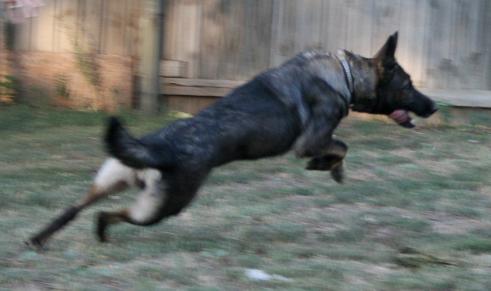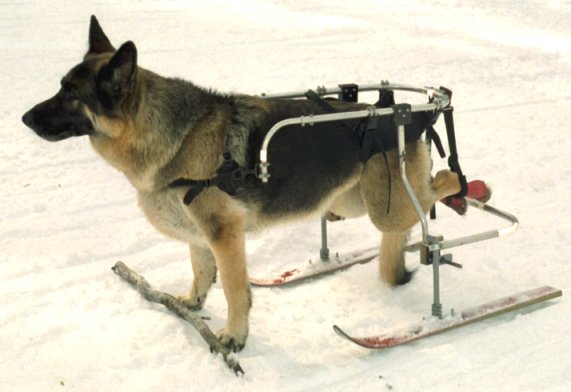~BUY FROM A BREEDER THAT TESTS~
Our Motto:
"We can't breed out every K-9 Disease, but Genetic Testing is a good start"
Browse the below page.
See all the diseases we test for and what your GSD could be at risk for if you are getting a puppy out of dogs that have not been tested and are NOT clear from the following diseases!
You'll find on our site the abbreviation "OFA "
OFA stands for "Orthopedic Foundation for Animals"
To go to their website click the link (Blue OFA badge) below:
www.pawprintgenetics.com is another company we use to provide many Genetic Health Tests we use!
We test for all the Diseases and Genetic ailments you see below!!!
(DM) Degenerative Myelopathy
Canine Degenerative Myelopathy
Breeding risks for degenerative myelopathy can be calculated using the Punnett Square:
- If both parents are clear (N/N) then all of the puppies will be clear However, it is important to remember that 1 German Shepherd Dog out of hundreds tested had developed Degenerative Myelopathy, so perhaps this 1 dog's test needs to be revisited!
- If one parent is a carrier (N/A) and one is clear (N/N) then roughly 50% of the puppies will be clear and 50% will be carriers
- If both parents are carriers (N/A) then roughly 25% will be clear (N/N), 50% will be carriers (N/A), and 25% will be affected (A/A)
- If one parent is clear (N/N) and one parent is affected (A/A) then all puppies will be carriers (N/A)
- If one parent is a carrier (N/A) and one is affected (A/A) then roughly 50% of the puppies will be carriers (N/A) and 50% will be affected (A/A)
- If both parents are affected (A/A) then all puppies will be affected (A/A)
Symptoms
Degenerative myelopathy initially affects the back legs and causes muscle weakness and loss, and lack of coordination. These cause a staggering affect that may appear to be arthritis. The dog may drag one or both rear paws when it walks. This dragging can cause the nails of one foot to be worn down. The condition may lead to extensive paralysis of the back legs. As the disease progresses, the animal may display symptoms such asincontinence and has considerable difficulties with both balance and walking. If allowed to progress, the animal will show front limb involvement and extensive muscle atrophy. Eventually cranial nerve or respiratory muscle involvement necessitates euthanasia.
Progression of the disease is generally slow but highly variable. The animal could be crippled within a few months, or may survive up to three years or more
Causes
The etiology of this disease is unknown. Recent research has shown that a mutation in the SOD1 gene is a risk factor for developing degnerative myelopathy in several breeds. Mutations in SOD1 are also associated with familial amyotrophic lateral sclerosis (Lou Gehrig's disease) in people. However, it has been discovered that 1 German Shepherd Dog that tested Clear (N/N) was found to have DM, upon necropsy. This German Shepherd Dog was found to be homozygous for the normal form of the SOD1 gene. German Shepherd Dog Myelopathy (aka GSDM) is its own unique disease. While ALS (amyotrophic lateral sclerosis) does not involve sensory loss, German Shepherd Dog Myelopathy involves complete sensory loss. Therefore, German Shepherd Dog Myelopathy is not the common form of DM which affects other breeds, which is the type of Myelopathy for which this test was developed.
Known causes of spinal cord dysfunction should be excluded before accepting the diagnosis of degenerative myelopathy; disc disease (protrusions) or spinal cord tumors can cause compression of the spinal cord with similar signs to degenerative myelopathy.
Treatment
Degenerative myelopathy is a non-reversible, progressive disease that cannot be cured. There are no treatments that have been clearly shown to stop or slow progression of DM.
Exercise
Exercise has been recommended to maintain the dog's ability to walk.Physiotherapy may prolong the length of time that the dog remains mobile and increase survival time.Canine hydrotherapy (swimming) may be more useful than walking. Use of a belly sling or hand-held harness allows the handler the ability to support the dog's hind legs for exercising or going up and down stairs. A 2-wheel dog cart, or 'dog wheelchair' can allow the dog to remain active and maintain its quality of life once signs of weakness or paralysis of the hind limbs is detected.
Sources
- ^ Kahn, Cynthia M.; Line, Scott, eds. (2005-02-08). "Degenerative Diseases". The Merck Veterinary Manual(9 ed.). Merck. ISBN 0-911910-50-6.
- ^ Awano T et al.: Genome-wide association analysis reveals a SOD1 mutation in canine degenerative myelopathy that resembles amyotrophic lateral sclerosis. Proc Natl Acad Sci U S A. 2009 Feb 2. Epub ahead of print [1]
- ^ Hovanessian, Natasha (2001-03-27). "Degenerative Myelopathy". Listing of Inherited Disorders in Animals. University of Sydney. Archived from the original on 2008-08-02. Retrieved 2008-07-25.
- ^ Awano, T.; Johnson, G. S.; Wade, C. M.; Katz, M. L.; Johnson, G. C.; Taylor, J. F.; Perloski, M.; Biagi, T. et al. (2009). "Genome-wide association analysis reveals a SOD1 mutation in canine degenerative myelopathy that resembles amyotrophic lateral sclerosis". Proceedings of the National Academy of Sciences 106 (8): 2794–2799. Bibcode 2009PNAS..106.2794A. doi:10.1073/pnas.0812297106.PMC 2634802. PMID 19188595. edit
- ^ M. D. Lorenz and J. N. Kornegay. Handbook of Veterinary Neurology, Philadelphia:W.B. Saunders Company, 2004, pp 147-9.
- ^ Kathmann I, I; Cizinauskas S, Doherr MG, Steffen F, Jaggy A. (July–August 2006). "Daily controlled physiotherapy increases survival time in dogs with suspected degenerative myelopathy". J Vet Intern Med20 (4): 927–932. doi:10.1892/0891-6640(2006)20[927:DCPIST]2.0.CO;2. PMID 16955818.
- ^ Clemmons, R.M. (2002-08-27). "Degenerative Myelopathy German Shepherd Dogs". University of Florida. Retrieved 2008-07-25.
External links
Anhidrotic ectodermal dysplasia is an inherited disease affecting German shepherd dogs. This disease most commonly presents at birth. Affected dogs are born with symmetrical hairlessness on the forehead and the area over the lower back. Malformed and/or absent teeth (oligodontia) are also a feature of the disorder. Dogs may also have an inability to sweat (anhidrosis) due to missing or abnormal sweat glands. Tear production can be abnormal and dogs often develop dry eye (keratoconjuncitivitis sicca). Affected dogs are more prone to respiratory infections than other dogs and frequently have chronic nasal discharge. Prognosis for survival to adulthood is good. However, affected dogs should be monitored for signs of respiratory infections (cough, rapid or difficult breathing, and exercise intolerance) as they are fatal in rare cases.
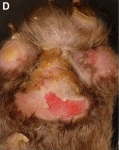
Breed-Specific Information for the German Shepherd Dog
The Mutation of the EDA gene associated with anhidrotic ectodermal dysplasia has been identified in German shepherd dogs, although its overall frequency in this breed is unknown.
Testing Tips
Genetic testing of the EDA gene in German shepherd dogs will reliably determine whether a dog is a genetic Carrier of anhidrotic ectodermal dysplasia. Anhidrotic ectodermal dysplasia is inherited in an X-Linked Recessive manner in dogs meaning that female dogs must receive two copies of the mutated gene (one from each parent) to develop the disease while male dogs only require one copy of the mutated gene from the mother in order to develop the disease. Therefore, male dogs more commonly present with symptoms of the disease. Although much less common, carrier female dogs may present with mild symptoms. Each male pup that is born to a female dog known to be a carrier of anhidrotic ectodermal dysplasia has a 50% chance of inheriting the disease. Female dogs that are not carriers of this Mutation have no increased risk of having affected pups. Reliable genetic testing is important for determining breeding practices. In order to eliminate this mutation from breeding lines and to avoid the potential of producing affected pups, breeding of known carriers is not recommended. German shepherd dogs that are not carriers of the mutation have no increased risk of having affected pups.
References
- Casal ML, Lewis JR, Mauldin EA, Tardivel A, Ingold K, Favre M, Paradies F, Demotz S, Gaide O, Schneider P. Significant correction of disease after postnatal administration of recombinant ectodysplasin A in canine X-linked ectodermal dysplasia. Am J Hum Genet. 2007 Nov; 81(5):1050-6. [PubMed: 17924345]
- Casal ML, Mauldin EA, Ryan S, Scheidt JL, Kennedy J, Moore PF, Felsburg PJ. Vet Immunol Immunopathol. Frequent respiratory tract infections in the canine model of X-linked ectodermal dysplasia are not caused by an immune deficiency. 2005 Aug 15; 107(1-2):95-104. [PubMed: 15946744]
- Casal ML, Scheidt JL, Rhodes JL, Henthorn PS, Werner P. Mutation identification in a canine model of X-linked ectodermal dysplasia. Mamm Genome. 2005 Jul; 16(7):524-31. [PubMed: 16151697]
- Kowalczyk C, Dunkel N, Willen L, Casal ML, Mauldin EA, Gaide O, Tardivel A, Badic G, Etter AL, Favre M, Jefferson DM, Headon DJ, Demotz S, Schneider P. J Biol Chem. 2011 Sep 2; 286(35):30769-79. Molecular and therapeutic characterization of anti-ectodysplasin A receptor (EDAR) agonist monoclonal antibodies. [PubMed: 21730053]
- Lewis JR, Reiter AM, Mauldin EA, Casal ML. Orthod Craniofac Res. 2010 Feb; 13(1):40-7. Dental abnormalities associated with X-linked hypohidrotic ectodermal dysplasia in dogs. [PubMed: 20078794]
- Mauldin EA, Gaide O, Schneider P, Casal ML. Am J Med Genet A. 2009 Sep; 149A(9):2045-9. Neonatal treatment with recombinant ectodysplasin prevents respiratory disease in dogs with X-linked ectodermal dysplasia. [PubMed: 19533784]
- Moura E, Cirio SM. Clinical and genetic aspects of X-linked ectodermal dysplasia in the dog -- a review including three new spontaneous cases. Vet Dermatol. 2004 Oct; 15(5):269-77. [PubMed: 15500478]
Hemophilia A (German shepherd dog, type 2) is an inherited bleeding disorder affecting German shepherd dogs. Hemophilia A (German shepherd dog, type 2) is caused by a deficiency of coagulation factor VIII, which is an essential protein needed for normal blood clotting. Affected dogs generally exhibit mild to moderate signs of a bleeding disorder. Affected dogs may bruise easily, have frequent nosebleeds, bleed from the mouth when juvenile teeth are lost, and experience prolonged bleeding after surgery or trauma. Dogs may show signs of lameness or stiffness if bleeding occurs in the joints or muscle. Less often, the bleeding may be severe enough to cause death. Due to the variable severity of the disorder, affected dogs may not be identified until a surgery is performed or trauma occurs at which time excessive bleeding is noted. Veterinarians performing surgery on known affected dogs should have ready access to blood banked for transfusions. Most dogs will have a normal lifespan with this condition despite increased blood clotting times.
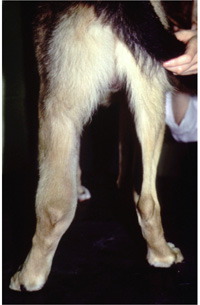
Breed-Specific Information for the German Shepherd Dog
The Mutation of the F8 gene associated with hemophilia A (German shepherd dog, type 2) has been identified in German shepherd dogs, although its overall frequency in this breed is unknown.
Testing Tips
Genetic testing of the F8 gene in German shepherd dogs will reliably determine whether a dog is a genetic Carrier of hemophilia A. Hemophilia A (German shepherd dog, type 2) is inherited in an X-Linked Recessive manner in dogs meaning that female dogs must receive two copies of the mutated gene (one from each parent) to develop the disease while male dogs only require one copy of the mutated gene from the mother in order to develop disease. Therefore, male dogs more commonly present with symptoms of the disease. Each male pup that is born to a female dog known to be a carrier of hemophilia A has a 50% chance of inheriting the disease. Reliable genetic testing is important for determining breeding practices. Because symptoms may be mild in affected dogs and female carriers generally do not have features of the disease, genetic testing should be performed before breeding. In order to eliminate this Mutation from breeding lines and to avoid the potential of producing affected pups, breeding of known carriers to each other is not recommended. German shepherd dogs that are not carriers of the mutation have no increased risk of having affected pups.
References
- Christopherson PW, Bacek LM, King KB, Boudreaux MK. Two novel missense mutations associated with hemophilia A in a family of boxers, and a German shepherd dog. Vet Clin Pathol. 2014 Sep;43(3):312-6. [PubMed: 25040606]
Hyperuricosuria is an inherited condition affecting German Shepherd Dogs. The SLC2A9 gene codes for a protein that allows the kidneys to transport uric acid from the urine. Dogs with mutations in both copies of the SLC2A9 gene are predisposed to have elevated levels of uric acid in the urine, hence the name hyperuricosuria. Uric acid can form crystals and/or stones (uroliths) in the urinary tract. Dogs with hyperuricosuria most commonly present with symptoms of recurrent urinary tract inflammation, which include frequent urination, blood in the urine, and straining to urinate. They may also have loss of appetite, lethargy, weakness, vomiting and pain. Urinary stones in the bladder can cause urinary tract infections or more seriously, blockage of the Urethra. Both male and female dogs can be affected, but obstruction of urine flow is more common in males due to differences in anatomy. Although an x-ray can be used to exclude other types of stones, urate stones cannot typically be seen using x-rays and must be evaluated by ultrasound. Not all dogs with mutations in both copies of the SLC2A9 gene will have symptoms of disease, though they will have increased uric acid excretion in the urine.
Breed-Specific Information for the German Shepherd Dog
The Mutation of the SLC2A9 gene associated with hyperuricosuria has been identified in German Shepherd Dogs. Though the exact frequency in the overall German Shepherd Dog population is unknown, based on 114 German Shepherd Dogs tested, 2.60% of German Shepherd Dogs from the United States are estimated to be carriers of the mutation and 0.02% are estimated to be at-risk for hyperuricosuria.
Testing Tips
Genetic testing of the SLC2A9 gene in German Shepherd Dogs will reliably determine whether a dog is a genetic Carrier of hyperuricosuria. Hyperuricosuria is inherited in an Autosomal Recessive manner in dogs meaning that they must receive two copies of the mutated gene (one from each parent) to develop the disease. In general, carrier dogs do not have features of the disease but when bred with another carrier of the same Mutation, there is a risk of having affected pups. Each pup that is born to this pairing has a 25% chance of inheriting the disease and a 50% chance of inheriting one copy and being a carrier of the SLC2A9 gene mutation. Reliable genetic testing is important for determining breeding practices. Because not all affected dogs will have clinical signs associated with hyperuricosuria, genetic testing should be performed before breeding. In order to eliminate this mutation from breeding lines and to avoid the potential of producing affected pups, breeding of known carriers to each other is not recommended. German Shepherd Dogs that are not carriers of the mutation have no increased risk of having affected pups.
References
- Bannasch D, Safra N, Young A, Karmi N, Schaible RS, Ling GV. Mutations in the SLC2A9 gene cause hyperuricosuria and hyperuricemia in the dog. PLoS Genet. 2008 Nov;4(11):e1000246. [PubMed: 18989453]
- Karmi N, Brown EA, Hughes SS, McLaughlin B, Mellersh CS, Biourge V, Bannasch DL. Estimated frequency of the canine hyperuricosuria mutation in different dog breeds. J Vet Intern Med. 2010 Nov-Dec; 24(6):1337-42. [PubMed: 21054540]
- Karmi N, Safra N, Young A, Bannasch DL. Validation of a urine test and characterization of the putative genetic mutation for hyperuricosuria in Bulldogs and Black Russian Terriers. Am J Vet Res. 2010 Aug; 71(8):909-14. [PubMed: 20673090]
Leukocyte adhesion deficiency type III is an inherited blood disorder affecting German Shepherd Dogs. Affected dogs have abnormal platelet and white blood cell activity resulting in abnormal blood clotting and immune system function. Dogs may present with lameness, prolonged bleeding and recurrent, chronic infections especially of the skin and gums and often accompanied by fever. Other symptoms include persistently elevated white blood cell counts (leukocytosis). Dogs can live for years with this condition although they are susceptible to life-threatening bleeding with an accidental injury or any surgical procedure. Veterinarians performing surgery on known affected dogs should have ready access to blood banked for transfusions.
Breed-Specific Information for the German Shepherd Dog
The Mutation of the FERMT3 gene associated with leukocyte adhesion deficiency type III has been identified in German Shepherd Dogs, although its overall frequency in this breed is unknown.
Testing Tips
Genetic testing of the FERMT3 gene in German Shepherd Dogs will reliably determine whether a dog is a genetic Carrier of leukocyte adhesion deficiency type III. Leukocyte adhesion deficiency type III is inherited in an Autosomal Recessive manner in dogs meaning that they must receive two copies of the mutated gene (one from each parent) to develop the disease. In general, carrier dogs do not have features of the disease but when bred with another carrier of the same Mutation, there is a risk of having affected pups. Each pup that is born to this pairing has a 25% chance of inheriting the disease and a 50% chance of inheriting one copy and being a carrier of the FERMT3 gene mutation. Reliable genetic testing is important for determining breeding practices. In order to eliminate this mutation from breeding lines and to avoid the potential of producing affected pups, breeding of known carriers to each other is not recommended. German Shepherd Dogs that are not carriers of the mutation have no increased risk of having affected pups.
References
- Boudreaux MK, Wardrop KJ, Kiklevich V, Felsburg P, Snekvik K. A mutation in the canine Kindlin-3 gene associated with increased bleeding risk and susceptibility to infections. Thromb Haemost. 2010 Feb; 103(2):475-7. [PubMed: 20126836]
Mucopolysaccharidosis (MPS) VII (shepherd type) is an inherited Lysosomal Storage Disorder affecting German shepherd dogs. Affected dogs have insufficient activity of the Enzyme beta-glucuronidase, which is responsible for breaking down glycosaminoglycans (GAGs). GAGs are an important component of Connective Tissue. In affected dogs, there is an accumulation of breakdown products in cells causing abnormal growth and function of various organ systems. Clinical signs of MPS VII (shepherd type) are most commonly associated with accumulations in the bones and joints. Therefore, affected dogs typically present between 4 to 8 weeks of age with symptoms of bone and joint disease. Affected puppies have disproportionally large heads with short muzzles, broad faces, low-set ears and domed skulls. Other skeletal deformities include broad chests, joint laxity and deformed, crooked legs resulting in an inability to walk by 5 months of age. Affected puppies also have cloudy eyes and are smaller than their normal littermates. Dogs may also present with heart problems. While affected dogs can survive with assistance for several years, they are often euthanized due to a poor quality of life.
Breed-Specific Information for the German Shepherd Dog
The Mutation of the GUSB gene associated with mucopolysaccharidosis VII (shepherd type) has been identified in German shepherd dog, although its overall frequency in this breed is unknown.
Testing Tips
Genetic testing of the GUSB gene in German shepherd dogs will reliably determine whether a dog is a genetic Carrier of mucopolysaccharidosis VII (shepherd type). Mucopolysaccharidosis VII (shepherd type) is inherited in an Autosomal Recessive manner in dogs meaning that they must receive two copies of the mutated gene (one from each parent) to develop the disease. In general, carrier dogs do not have features of the disease but when bred with another carrier of the same Mutation, there is a risk of having affected pups. Each pup that is born to this pairing has a 25% chance of inheriting the disease and a 50% chance of inheriting one copy and being a carrier of the GUSB gene mutation. Reliable genetic testing is important for determining breeding practices. In order to eliminate this mutation from breeding lines and to avoid the potential of producing affected pups, breeding of known carriers to each other is not recommended. German shepherd dogs that are not carriers of the mutation have no increased risk of having affected pups.
References
- Haskins ME, Aguirre GD, Jezyk PF, Schuchman EH, Desnick RJ, Patterson DF. Mucopoysaccharidosis type VII (Sly Syndrome). Beta-glucuronidase-deficient mucopolysaccharidosis in the dog. Am J Pathol. 1991 Jun;138(6):1553-5.[PubMed: 1905109]
- Ray J, Bouvet A, DeSanto C, Fyfe JC, Xu D, Wolfe JH, Aguirre GD, Patterson DF, Haskins ME, Henthorn PS. Cloning of the canine beta-glucuronidase cDNA, mutation identification in canine MPS VII, and retroviral vector-mediated correction of MPS VII cells. Genomics. 1998 Mar 1; 48(2):248-53. [PubMed: 9521879]
- Ray J, Haskins ME, Ray K. Am J Vet Res. Molecular diagnostic tests for ascertainment of genotype at the mucopolysaccharidosis type VII locus in dogs. 1998 Sep; 59(9):1092-5. [PubMed: 9736382]
- Silverstein Dombrowski DC, Carmichael KP, Wang P, O'Malley TM, Haskins ME, Giger U. Mucopolysaccharidosis type VII in a German Shepherd Dog. J Am Vet Med Assoc. 2004 Feb 15;224(4):553-7, 532-3. [PubMed: 14989549]
Multidrug resistance 1, also called MDR1, is an inherited condition affecting several breeds of dogs, especially herding dogs such as the German Shepherd Dog. The Mutation in the ABCB1 gene associated with MDR1 causes dysfunction of P-glycoprotein, which is responsible for removing certain drugs and toxins from the body. Clinical signs are most commonly associated with distribution of the drug in the central nervous system. If an at-risk dog is treated with one of several common drugs (see below*), they are at risk of developing neurologic symptoms that could range from tremors, excess salivation, anorexia and blindness to coma and even death. Because of the defective ability to metabolize specific drugs, these drugs can be lethal even at low doses. The MDR1 mutation does not cause adverse effects in dogs unless the dog is exposed to these drugs. Therefore, veterinarians should be notified when a dog is at risk for multidrug resistance 1 prior to administration of any medications.
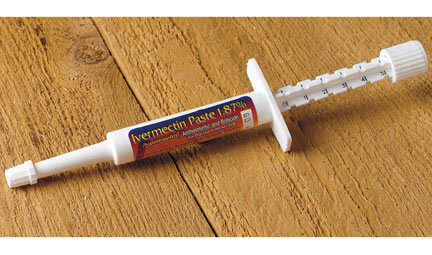
*Drugs known to cause neurological signs related to the MDR1 mutation:
Acepromazine, butorphanol, doxorubicin, emodepside, erythromycin, ivermectin, loperamide, milbemycin, moxidectin, rifampin, selamectin, vinblastine and vincristine
In addition to this list, there are many other drugs known to be removed from the central nervous system via the P-glycoprotein mechanism in humans. However, reports of neurological dysfunction related to drugs other than those listed here are scarce in dogs. Please consult your veterinarian prior to giving drugs to known multidrug resistance 1 carriers, affected dogs, or untested dogs of breeds commonly affected with this condition.
Breed-Specific Information for the German Shepherd Dog
The Mutation of the ABCB1 gene associated with multidrug resistance 1 has been identified in the German Shepherd Dog. Though the exact frequency in the overall German Shepherd Dog population is unknown, 8.4% out of 166 German Shepherd Dogs were carriers and 1.8% were at-risk.
Testing Tips
Genetic testing of the ABCB1 gene in German Shepherd Dogs will reliably determine whether a dog is a genetic Carrier of multidrug resistance 1. Multidrug resistance 1 is inherited in an autosomal incomplete dominant manner in dogs meaning that dogs only need to inherit one copy of the mutated gene to be at an increased risk of developing the disease. Though adverse reactions to certain drugs are most commonly seen in dogs having two copies of the mutated gene, carrier dogs can also experience drug sensitivities and dosages need to be adjusted accordingly. Thus, dogs that have one or two mutant copies of the gene are considered at-risk for adverse drug reactions. When carriers of this Mutation are bred with another dog that also is a carrier of the same mutation, there is risk of having affected pups. For each pup that is born to this pairing, there is a 25% chance that the puppy will inherit two copies of the mutation and a 50% chance that the puppy will inherit one copy of the mutation and, in either case, may be susceptible to having adverse drug reactions. Reliable genetic testing is important for determining breeding practices. Because symptoms do not appear unless dogs are exposed to certain drugs, genetic testing should be performed before breeding. In order to eliminate this mutation from breeding lines and to avoid the potential of producing affected pups, breeding of known carriers is not recommended. German Shepherd Dogs that are not carriers of the mutation have no increased risk of having affected pups when bred to a dog that is also clear for this mutation.
References
- Alves L, Hulsmeyer V, Jaggy A, Fischer A, Leeb T, Drogemuller M. Polymorphisms in the ABCB1 gene in phenobarbital responsive and resistant idiopathic epileptic border collies. J Vet Intern Med. 2011 May-Jun;25(3):484-9. [PubMed: 21488961]
- Barbet JL, Snook T, Gay JM, Mealey KL. ABCB1-1 Delta (MDR1-1 Delta) genotype is associated with adverse reactions in dogs treated with milbemycin oxime for generalized demodicosis. Vet Dermatol. 2009 Apr;20(2):111-4. [PubMed: 19171022]
- Geyer J, Klintzsch S, Meerkamp K, Wohlke A, Distl O, Moritz A, Petzinger E. Detection of the nt230(del4) MDR1 mutation in White Swiss Shepherd dogs: case reports of doramectin toxicosis, breed predisposition, and microsatellite analysis. J Vet Pharmcol Ther. 2007 Oct;30(5):482-485. [PubMed: 17803743]
- Gramer I, Leidolf R, Doring B, Klintzsch S, Kramer E, Yalcin E, Petzinger E, Geyer J. Breed distribution of the nt230(del4) MDR1 mutation in dogs. Vet J. 2011 Jul;189(1):67-71. [PubMed: 20655253]
- Mealey KL, Bentjen SA, Gay JM, Cantor GH. Ivermectin sensitivity in collies is associated with a deletion mutation of the mdr1 gene. Pharmacogenetics. 2001 Nov; 11(8):727-33. [PubMed: 11692082]
- Mealey KL, Meurs KM. Breed distribution of the ABCB1-1delta (multidrug sensitivity) polymorphism among dogs undergoing ABCB1 genotyping. J Am Vet Med Assoc. 2008 Sep 15;233(6):921-4. [PubMed: 18795852]
- Mizukami K, Chang H, Yabuki A, Kawamichi T, Hossain MA, Rahman MM, Uddin MM, Yamato O. Rapid genotyping assays for the 4-base pair deletion of canine MDR1/ABCB1 gene and low frequency of the mutant allele in border collie dogs. J Vet Diagn Invest. 2012 Jan;24(1):127-34. [PubMed: 22362942]
- Neff MW, Robertson KR, Wong AK, Safra N, Broman KW, Slatkin M, Mealey KL, Pedersen NC. Breed distribution and history of canine mdr1-1delta, a pharmacogenetic mutation that marks the emergence of breeds from the collie lineage. Proc Natl Acad Sci U S A. 2004 Aug 10;101(32):11725-30. [PubMed: 15289602]
- Nelson OL, Carsten E, Bentjen SA, Mealey KL. Ivermectin toxicity in an Australian shepherd dog with the MDR1 mutation associated with ivermectin sensitivity in collies. J Vet Intern Med. 2003 May-Jun;17(3):354-6. [PubMed: 12774979]
Renal cystadenocarcinoma and nodular dermatofibrosis is an inherited genetic predisposition to kidney, dermal and uterine cancer in German Shepherd Dogs. This condition manifests as a combination of abnormal masses in the kidneys and the skin of both male and female dogs and also the uterus in female dogs. Affected dogs usually present around 6.5 years of age with small, firm bumps under the surface of the skin, more commonly located on the limbs and head. The kidney tumors often form nodular masses and cysts that can cause the kidneys to become enlarged, abnormally shaped and scarred. Affected dogs often show signs of chronic kidney disease which may include frequent urination, blood in the urine, frequent drinking, depression, inappetence and weight loss. The disease typically presents over the age of 5, and tumors may not develop until dogs are 9 to 11 years of age. The average age of death for affected dogs is 9.3 years due to renal failure or metastatic disease. Puppies that inherit two copies of the FLCN gene Mutation most likely die very early in gestation; therefore, breeding two dogs with renal cystadenocarcinoma and nodular dermatofibrosis may result in reduced litter size.
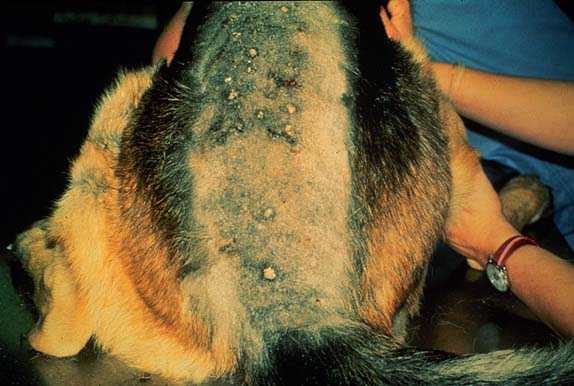
Breed-Specific Information for the German Shepherd Dog
The Mutation of the FLCN gene associated with renal cystadenocarcinoma and nodular dermatofibrosis has been identified in German Shepherd Dogs, although its overall frequency in this breed is unknown.
Testing Tips
Genetic testing of the FLCN gene in German Shepherd Dogs will reliably determine whether a dog is a genetic Carrier of renal cystadenocarcinoma and nodular dermatofibrosis. Renal cystadenocarcinoma and nodular dermatofibrosis is inherited in an Autosomal Dominant manner in dogs meaning that dogs only need to inherit one copy of the mutated gene to be at-risk for the disease. Puppies that inherit two copies of the genetic Mutation most likely die In Utero. Each pup that is born to a parent carrying one copy of the mutation has a 50% chance of inheriting one copy of the FLCN gene mutation and being at-risk for the disease. Because symptoms do not appear until adulthood, genetic testing should be performed before breeding. Reliable genetic testing is important for determining breeding practices. In order to eliminate this mutation from breeding lines and to avoid the potential of producing affected pups, breeding of known carriers is not recommended. German Shepherd Dogs that are not carriers of the mutation have no increased risk of having affected pups due to this mutation.
References
- Jónasdóttir TJ, Mellersh CS, Moe L, Heggebø R, Gamlem H, Ostrander EA, Lingaas F. Genetic mapping of a naturally occurring hereditary renal cancer syndrome in dogs. Proc Natl Acad Sci U S A. 2000 Apr 11; 97(8):4132-7. [PubMed: 10759551]
- Lingaas F, Comstock KE, Kirkness EF, Sørensen A, Aarskaug T, Hitte C, Nickerson ML, Moe L, Schmidt LS, Thomas R, Breen M, Galibert F, Zbar B, Ostrander EA. A mutation in the canine BHD gene is associated with hereditary multifocal renal cystadenocarcinoma and nodular dermatofibrosis in the German Shepherd dog. Hum Mol Genet. 2003 Dec 1; 12(23):3043-53. [PubMed: 14532326]
Other Diseases and Health Risks for your German Shepherd:
The below Diseases may not be the result of a genetic trait or no test is available at this time.
It is however important to know all about this breed to be aware of any symptoms your GSD may have, to better catch early development of a disease to help treat it!



